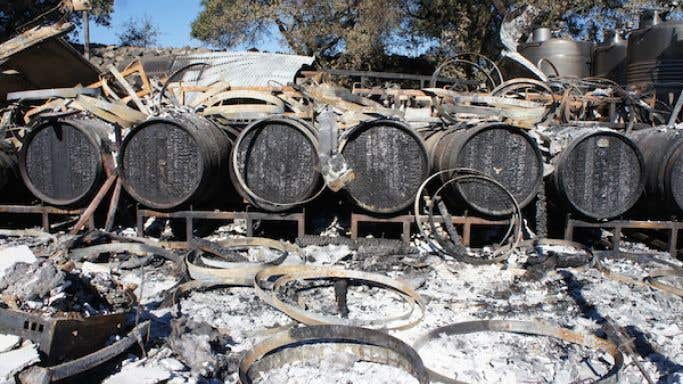Unlike his winery, Igor Sill of Sill Family Vineyards survived the Napa fires and continues to farm his mountain vineyard on Atlas Peak Mountain. He’s a member of the Napa Valley Wine Technical Group and has judged in the International Wine Challenge in London. Our fundraising wine tasting for the worst-hit victims of the fires takes place in London this Saturday evening. Check out ticket availability here.
For those in Napa affected by the recent fires there lies a very long road ahead for recovery. The Napa fires ignited a life-changing and forever memorable event for all of us in the wine industry. Like many other viticulturists we had just finished our late-season harvest and were focused on crafting our 2017 wines when the fires hit. That following morning, a reddish orange sun squinted through the smoke-filled skies as the fire raged on.
For our Atlas Peak Mountain Winery, the raging firestorm fuelled by howling winds claimed our winery, wines ageing in barrels, winery equipment, guest house and all out-buildings, but our Cabernet Sauvignon and Merlot vineyards emerged unscathed. The fire came up to the very edge of the vineyard and stopped. The vineyards, which hold moisture, acted as a natural firebreak and were an absolute godsend.
Though we lost much, we are truly grateful to the heroic efforts of firefighters and first responders from all over the country who helped protect our lives, homes, wineries, vineyards and businesses. I was completely amazed seeing the stark contrast between our scorched winery and the very much alive, green vineyards that remained untouched once the smoke cleared. I’m absolutely convinced that the vineyards slowed the fire and saved lives.
Even following the fire’s devastation, Napa remains a truly beautiful and magical place, peopled by a very supportive community. While we have been through a heartbreaking event and witnessed so much loss, the outpouring of support from everyone has been amazing.
As my vintner neighbour conveyed, ‘the harsher the fire, the more prosperous the rebuild’ (Chinese proverb), and with 2017 harvest behind us, neither the vineyards, the vintage nor our intense devotion have diminished. Napans will continue to craft exquisite, premium wines each and every day.
Napa is well known around the world for its exceptional wines, and the appellation which, I believe, surpasses all others is Napa’s famed Atlas Peak mountain region – now Napa’s hottest wine region, so to speak. Apart from its volcanic roots, it’s the high-elevation terroir and ultra-high-quality grapes that lend these boutique vineyards and wineries their magic and mystique.
Most of us are familiar with the famous Napa Valley floor wineries such as Mondavi, Beringer, V Sattui, Opus One and Inglenook, but lesser known are the small vintners and wine creators high above in Napa’s Atlas Peak volcanic region. Even though it's just minutes from the hustle and bustle of tourist-rich Napa, it remains a completely different world.
These mountain vineyards survived the fire and remain home to generations of winemakers whose passion to craft the world’s truly exquisite wines remains their sole pursuit.
Only 3% of the wine grapes grown in California are grown at elevations above 1,000 feet (300 m). It is widely known that the most costly and exceptional wines tend to come from these high-elevation mountain vineyards, where the terroir provides a mystical and divine setting.
The mountains are more exposed to prevailing winds, adding more stress to the vines. Essentially, higher-elevation mountain vineyards benefit in several ways over valley-floor vines. They receive more concentrated sunlight, greater temperature variation and far better drainage, which creates a natural stress to the vines as they struggle to develop greater pigment concentration. As a result, they produce more intense aromas, flavours, colours and tannins, evolving more slowly and ageing much more gracefully.
Mountain wines tend to be produced in small quantities, hence the reason that many of Napa’s expensive ‘cult’ wines are from high elevations. Making things difficult for the vine, by withholding fertilisers, making nutrients scarce, pruning it hard and crowding it with competing vine neighbours can take the wine to another level.
Renowned Bordeaux-based oenologist Michel Rolland said, ‘These mountain grapes are far more difficult to farm and the growing season tends to be considerably longer. It’s much more difficult to plant, more difficult to establish the vines and they produce far lower yields. However, the end result is a grape expressing intensity of stellar quality as difficult growing conditions often lead to extraordinary wines.’
Wine is born of passion, evolving over time, offering a truly beautiful thing that speaks to us through heightened sensory emotions that can sometimes reflect wonderful universal mysteries in a surprising fashion, evoking one of life’s many unforgettable pleasures. I think the people who plant vineyards at higher elevations possess a different sort of inner motivation and optimism, perhaps more in harmony with Ernest Hemingway’s view that ‘wine is one of the most civilised and natural things of the world that has been brought to the greatest perfection’. It is good to know that luscious healthy pleasures can be derived from the mountain vines that survived Napa’s fires.
